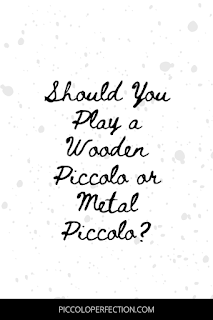How to Play Flute and Piccolo Together
Do you want to be able to play more music? Consider learning how to play flute and piccolo together during a single performance or even a single piece.
Then, you can enjoy your time as a musician. Even if you never make money with music, you can spread your love of it with more people.
Before we get into the how and why of playing flute and piccolo, this post contains affiliate links. Click here to read the full disclosure policy.
Why Play Flute and Piccolo
If you can play the flute and piccolo, you can enjoy a lot of benefits. Even if you have no plans of becoming a professional musician, playing multiple instruments is great.
The flute and piccolo are so similar that it makes sense to learn both. But if you still aren't convinced, you should know how playing more than one instrument can benefit you.
Then, you can grow as a musician and continue enjoying playing.
More Opportunities
When you can play flute and piccolo, you'll have access to more opportunities. This is true compared to someone who just plays one instrument or the other.
For example, an orchestra may have three flute spots. But one of those spots requires the musician to play piccolo on almost every piece.
Even the second flute player will occasionally have to play a piccolo part. So if you don't play the piccolo, you only have a shot at one flute part in an orchestra. And if you don't play the flute, your options get even more limited.
More Music
The flute and piccolo have the same written range. But if you can play both, you'll have access to a lot more music than you otherwise would.
You can play flute pieces, piccolo pieces, and you can do that solo or in an ensemble. Sure, you can play a piccolo piece on the flute or a flute piece on the piccolo.
However, it can be hard to get the original sound that the composer intended. When you can switch between the flute and piccolo, you'll have more choices when it comes to what music you want to learn.
More Fun
Some people may prefer to stick to one instrument. But I find it fun to be able to switch to different instruments throughout my practice.
If I'm not feeling the flute, I can play the piccolo, and vice versa. That's especially nice if I ever develop tension in my hands when playing the flute.
Going the other way, if I don't want to deal with earplugs, I can practice the piccolo later. It gives me a lot more flexibility, so I can enjoy music how I want.
How to Switch Between Flute and Piccolo
If you want to enjoy the benefits of playing multiple flutes, you should know how to do so correctly. It can be all too easy to overwork yourself and develop an injury or another problem.
As you start to learn the piccolo, assuming you can play the flute, you'll want to integrate the two. Then, you won't lose your flute skills, and your piccolo playing can complement your current abilities.
Here are a few things I recommend that you do as you start to play the flute and piccolo.
Get Good Instruments
Having a good quality flute or piccolo is already important. But when you have to juggle multiple instruments, it matters even more.
If your flute or piccolo is giving you problems, you won't be able to practice as efficiently. Then, you may not be able to make as much progress on both instruments.
You don't need to spend thousands of dollars on a good flute or piccolo. But you do need an instrument that will stay in playing condition for at least a year before you need maintenance.
Practice the Flute
Of course, to play flute and piccolo, you have to know how to play the flute. Most people learn to play the flute first, so that isn't a problem.
A problem develops when you stop playing your flute in favor of your piccolo. So make sure you continue to devote plenty of time to the flute each time you practice.
Then, you'll be able to keep up with your playing skills. You won't have to lose what you've worked so hard to do as a flutist.
Practice the Piccolo
As you start to learn the piccolo, you need to give that instrument enough practice time. That way, you can improve your skills.
Sure, there are some similarities between the two instruments. But the differences can be more significant than many people think.
And those differences can turn into problems when you start to play more complex music. So be sure to give yourself enough time to practice your piccolo each day.
Practice Switching
Once you reach a good level on both instruments, you can practice both together. Now, that doesn't mean you play both at the same time.
But you should practice switching between the two instruments. At first, this may mean practicing flute for a few minutes, then spending another few minutes on the piccolo.
However, you should eventually work up to being able to switch between instruments quickly. Then, you can play music that requires the use of both flutes.
Play the Same Music
Another thing to try to learn how to play flute and piccolo in one session is to play the same music on both. Look for pieces that stay in the first or second octave.
If the piece is in the second octave, for example, play it as written on the flute. Set the flute down, and grab your piccolo, but play the music as if it's in the first octave.
The music will sound the same since the piccolo sounds an octave higher. You can also figure out what you need to do with your embouchure to switch between the flute and piccolo.
Be Consistent
You may already know this from playing the flute and the piccolo separately. But the more consistent you are, the faster you'll improve at your instrument.
The same applies when it comes to learning how to play both instruments together. Set aside a few minutes each day to practice both instruments back to back in one go.
Over time, the switch will become natural, and you'll be able to do it without too much thought. That can then save you a lot of time and frustration, and you can enjoy more music and opportunities.
Reassess Your Schedule
If you find that you can't be consistent, take a look at your schedule and practice routine. Try to adjust your schedule so that you have time to practice both flutes.
You may also want to reduce your flute practice to give more time to the piccolo. Or you might need to give up the time you spend watching Netflix.
Practicing multiple instruments doesn't have to consume your life. But it does require more time than just playing one, so consider how you can make the most of your time.
Best Piccolos for the Switch
If you want a good piccolo to use as you first learn, you should do some shopping. There are tons of models out there, and some are better for beginners than others.
To help you find the right piccolo for your needs, I found some of the best ones out there. Be sure to test them all yourself to decide which you like the best.
Armstrong 204
I started learning the piccolo on an Armstrong 204. It's a silver-plated model, so it's very similar to the flute in terms of look, sound, and feel.
You can get a good foundation of piccolo playing on this instrument. Since it's metal, you can play it inside, outside, or wherever you want.
This instrument is perfect for students, but adults and professional musicians should also try it. You might find it's the right piccolo for you.
Pearl 105
Another flute I'd recommend for switching between it and the flute is the Pearl 105. The piccolo is grenaditte, which is a composite material that combines wood and plastic.
Plastic helps keep the wood from cracking, but the wood gives you a warm tone. It can be an excellent choice for someone who plays in an orchestra.
You don't have to worry as much about sounding shrill when playing this piccolo. And this can be a great long-term model for someone who doesn't want to deal with a wood instrument.
Yamaha YPC-32
The Yamaha YPC-32 has a silver-plated headjoint and a plastic body. That combination is pretty common among student piccolos, and it's a great choice for new players.
Because of the materials, it's pretty durable and great for playing inside and out. And you can use it for a long time without a ton of issues.
Plus, the metal headjoint has a lip plate that can help you switch from the flute. Then, you don't have to adjust your playing as much, but it will still be a bit different.
Yamaha YPC-62
If you need a wood piccolo, you can't go wrong with the Yamaha YPC-62. This model uses grenadilla wood, so you can get a warm, full sound.
It's an entry-level professional model, but it's not that much more expensive than some piccolos. So you could get a much better sound for not much more money.
That makes this piccolo a good upgrade for a casual player. If you can't justify spending twice as much on an upgrade, you may love how this model plays.
Will You Play Flute and Piccolo?
Knowing how to play flute and piccolo can open up a lot of doors for you as a musician. Whether you decide to become a professional or not, you can join more ensembles and play more solo pieces.
You don't have to become a piccolo specialist to enjoy the small flute. All you have to do is learn how to play it just like you learned how to play the flute.




Comments
Post a Comment